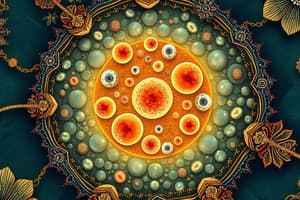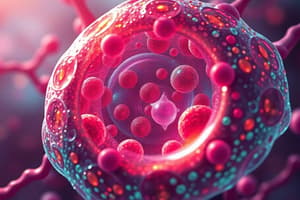Podcast
Questions and Answers
What is the main function of the cell membrane?
What is the main function of the cell membrane?
- Storage of genetic material
- Synthesizing proteins
- Generating ATP
- Regulating the movement of substances (correct)
Which of the following is a characteristic unique to prokaryotic cells?
Which of the following is a characteristic unique to prokaryotic cells?
- Presence of a nucleus
- Containment of ribosomes
- Absence of membrane-bound organelles (correct)
- Ability to perform aerobic respiration
Which organelle is primarily responsible for energy production via aerobic respiration?
Which organelle is primarily responsible for energy production via aerobic respiration?
- Golgi Apparatus
- Endoplasmic Reticulum
- Nucleus
- Mitochondria (correct)
What is the primary role of ribosomes in the cell?
What is the primary role of ribosomes in the cell?
Which metabolic process occurs in the cytoplasm and involves breaking down glucose?
Which metabolic process occurs in the cytoplasm and involves breaking down glucose?
Which organelle modifies, sorts, and packages proteins and lipids?
Which organelle modifies, sorts, and packages proteins and lipids?
What type of respiration occurs without oxygen and produces less ATP?
What type of respiration occurs without oxygen and produces less ATP?
What is the main component of the plant cell wall that provides structural support?
What is the main component of the plant cell wall that provides structural support?
Which type of endoplasmic reticulum is involved in lipid synthesis and detoxification?
Which type of endoplasmic reticulum is involved in lipid synthesis and detoxification?
Which of the following statements about eukaryotic cells is true?
Which of the following statements about eukaryotic cells is true?
Flashcards are hidden until you start studying
Study Notes
Cell Structure
- Basic Unit of Life: Cells are the fundamental building blocks of all living organisms.
- Types of Cells:
- Prokaryotic Cells: Lack a nucleus and membrane-bound organelles (e.g., bacteria).
- Eukaryotic Cells: Have a nucleus and membrane-bound organelles (e.g., plant and animal cells).
- Cell Membrane:
- Composed of a phospholipid bilayer with embedded proteins.
- Functions as a barrier, regulating the movement of substances in and out of the cell.
- Cytoplasm: Gel-like substance where cellular components are suspended; site for metabolic processes.
- Nucleus: Contains genetic material (DNA); regulates cell activities and gene expression.
Cell Organelles
- Mitochondria:
- Known as the "powerhouse of the cell".
- Site of aerobic respiration, producing ATP (energy currency).
- Endoplasmic Reticulum (ER):
- Rough ER: Studded with ribosomes; synthesizes proteins.
- Smooth ER: Lacks ribosomes; involved in lipid synthesis and detoxification.
- Ribosomes: Sites of protein synthesis; can be free-floating or attached to the rough ER.
- Golgi Apparatus: Modifies, sorts, and packages proteins and lipids for secretion or delivery to other organelles.
- Lysosomes: Contain digestive enzymes; break down waste materials and cellular debris.
- Chloroplasts (in plant cells): Site of photosynthesis; contains chlorophyll for capturing sunlight.
- Cell Wall (in plant cells): Provides structural support and protection; composed mainly of cellulose.
Cell Metabolism
- Definition: The sum of all biochemical reactions in a cell, including catabolism (breakdown) and anabolism (synthesis).
- Energy Production:
- Aerobic Respiration: Uses oxygen to convert glucose into ATP; occurs in mitochondria.
- Anaerobic Respiration: Occurs without oxygen; produces less ATP (e.g., fermentation).
- Metabolic Pathways:
- Glycolysis: Breakdown of glucose into pyruvate; occurs in the cytoplasm.
- Krebs Cycle: Processes pyruvate in the mitochondria to generate energy carriers (NADH, FADH2).
- Electron Transport Chain: Uses energy carriers to produce ATP through oxidative phosphorylation.
- Biosynthesis: The process of synthesizing complex molecules from simpler ones, essential for cell growth and repair.
Cell Structure
- Cells are the basic unit of life for all organisms.
- Prokaryotic cells lack a nucleus and membrane-bound organelles, typical in bacteria.
- Eukaryotic cells possess a nucleus and membrane-bound organelles, common in plants and animals.
- The cell membrane consists of a phospholipid bilayer with proteins, regulating substance movement.
- Cytoplasm is a gel-like matrix that holds cellular components and hosts metabolic reactions.
- The nucleus houses genetic material (DNA) and governs cell activities and gene expression.
Cell Organelles
- Mitochondria act as the "powerhouse of the cell," facilitating aerobic respiration and ATP production.
- The endoplasmic reticulum (ER) has two forms:
- Rough ER, which is ribosome-studded and synthesizes proteins.
- Smooth ER, which lacks ribosomes and is involved in lipid synthesis and detoxification.
- Ribosomes are the sites of protein synthesis, found free-floating in the cytoplasm or attached to rough ER.
- The Golgi apparatus modifies, sorts, and packages proteins and lipids for secretion or delivery.
- Lysosomes contain digestive enzymes for breaking down waste and cellular debris.
- Chloroplasts, found in plant cells, are responsible for photosynthesis and contain chlorophyll for capturing sunlight.
- The cell wall, also in plant cells, is made mainly of cellulose, providing structural support and protection.
Cell Metabolism
- Metabolism encompasses all biochemical reactions in a cell, including catabolic (breakdown) and anabolic (synthesis) processes.
- Aerobic respiration utilizes oxygen to convert glucose into ATP and occurs within mitochondria.
- Anaerobic respiration takes place without oxygen and produces less ATP, exemplified by fermentation.
- Glycolysis breaks down glucose into pyruvate in the cytoplasm.
- The Krebs cycle processes pyruvate in mitochondria to create energy carriers like NADH and FADH2.
- The electron transport chain generates ATP via oxidative phosphorylation, using energy carriers.
- Biosynthesis involves constructing complex molecules from simpler ones, crucial for cell growth and repair.
Studying That Suits You
Use AI to generate personalized quizzes and flashcards to suit your learning preferences.




